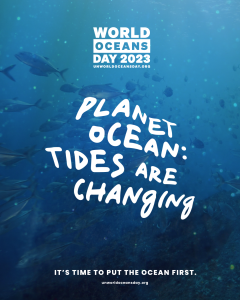 Planet Ocean: tides are changing
Planet Ocean: tides are changing
The ocean covers over 70% of the planet. It is our life source, supporting humanity’s sustenance and that of every other organism on earth.
The ocean produces at least 50% of the planet’s oxygen, it is home to most of earth’s biodiversity, and is the main source of protein for more than a billion people around the world. Not to mention, the ocean is key to our economy with an estimated 40 million people being employed by ocean-based industries by 2030.
Even though all its benefits, the ocean is now in need of support.
With 90% of big fish populations depleted, and 50% of coral reefs destroyed, we are taking more from the ocean than can be replenished. We need to work together to create a new balance with the ocean that no longer depletes its bounty but instead restores its vibrancy and brings it new life.
“Planet Ocean: tides are changing”, is the theme for World Oceans Day 2023 – the UN is joining forces with decision-makers, indigenous leaders, scientists, private sector executives, civil society, celebrities, and youth activist to put the ocean first.
Did you know?
- The ocean produces at least 50% of the planet’s oxygen.
- The ocean is key to our economy with an estimated 40 million people being employed by ocean-based industries by 2030.
- Oceans absorb about 30% of carbon dioxide produced by humans, buffering the impacts of global warming.
World Oceans Day reminds every one of the major role the oceans have in everyday life. They are the lungs of our Planet and a major source of food and medicine and a critical part of the biosphere.
 Contemporary climate change includes both the global warming caused by humans, and its impacts on Earth’s weather patterns. There have been
Contemporary climate change includes both the global warming caused by humans, and its impacts on Earth’s weather patterns. There have been